Audi allroad returns with all-road perfection
By John Gilbert
A couple of decades — and an SUV craze or two — ago, a good friend of my younger son asked me how wise it would be to buy a used Audi allroad, which was a very nice and svelte station wagon-type vehicle that you could actually take off the road because of some armor-plating underneath.
Now, I’ve always been a big fan of Audi’s technology, and I’ve visited the Audi home plant in Ingolstadt, Germany, a couple of times, but I issued a word of caution to my young friend, because the word behind the scenes at that time was that Audi was going to discontinue the allroad because of slow sales. So he bought something else.
Flash forward a few years, and I saw an allroad and I realized that the drivetrain and all the mechanicals were all fine in the car, and my advice was premature for a young family in St. Paul. Now it is 2017, and while Audi is at the top of its game in competing with BMW and Mercedes for fine German car sales, I paused in my favorable impression of a new Audi A4 sedan because my test car for a mid-February week was (trumpets, please) a 2017 Audi allroad.
After this review gets filed, I’m going to notify my son’s friend and apologize for my hasty suggestion years ago, and advise him that maybe he should look anew at the allroad. Incidentally, at Audi’s insistence, allroad is spelled with a lower-case “a” just as its quattro all-wheel-drive system is spelled with a lower-case “q.” In fact, it’s amusing to note that Motor Trend, Car & Driver, and other auto publications insist on spelling it with a cap Quattro, as though that distinction makes them superior in some fashion.
The new allroad is all-new, and it is a superb vehicle, with, of course, quattro, which made confronting a Northern Minnesota snowstorm and its below-zero after-effects a simple matter, both for traction, stability, and exercising those seat-heaters.
It is based on the platform of the new A4 sedan, which has grown up in recent years with its price rising with its sophistication. It is now Audi’s base compact/midsize sedan, pushing the larger A6 and A8 up a couple of price categories.
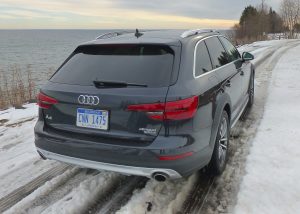
The all road’s sleekness belies its higher stance, underside armor and storage room under the hatch.
You could think of the allroad as an A4 station wagon, if that term wasn’t so outdated by contemporary customers. That means it is compact, smooth, agile, has a lot of storage space, and can be handled well by the ubiquitous 2.0-liter turbocharged 4-cylinder gasoline engine, tweaked to develop 252 horsepower and 273 foot-pounds of torque.
It will tow 1,000 pounds, and, like its predecessor, it will serve for some light off-road duty — although it is so classy that taking it into the rugged underbrush might qualify you for a therapy couch.
Because it’s based on the A4, the allroad looks lower and sleeker than you anticipate, despite the fact it is built with nearly an inch and a half more ground clearance than the A4.
The turbo gives the comparatively small 2-liter plenty of punch, and it’s all coordinated through Audi’s 7-speed dual-clutch automatic, which is basically a clutchless manual that has two separate clutches within the transmission, one handling first-third-fifth and seventh, and the other engaging second-fourth and sixth. If you want to use the paddles to shift, you get instantaneous upshifts or downshifts, because all that’s required is the computerized transmission to switch which clutch is engaged.
Audi’s proliferation of models means that the allroad is not to be confused with the “Q-ships,” the large Q7, midsize Q5, compact Q3, and the soon to be introducted Q2. Those are definitely SUVs of the crossover variety.
The allroad’s appeal includes all sorts of high-tech connectivity tricks, including 4GLTE connectivity, Audi’s MMI interface, the allroad drive-select system, which allows you to choose comfort, dynamic, or individually set preferences for steering, suspension and shift-points.
And it has one of my favorite features, which Audi calls its virtual cockpit. Along with a very efficient normal-sized navigation and information screen atop the dashboard, you can fiddle with the steering wheel switchwork to change the normal tach and speedometer-based instrument panel into an incredible, 12.3-inch panoramic scene of where you’re going. It’s a glorified GPS, but it is indeed glorified.
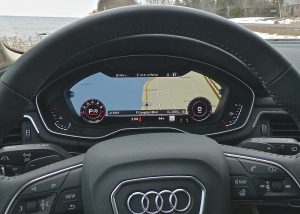
Clever cockpit idea gives allroad electronic capability to reduce gauge size and provide an easily seen panoramic GPS.
When you rack it over and get the GPS background behind the tach and speedometer, you can click a “view” button, and the tach and speedometer instantly are reduced to very small instruments in the lower left and lower right, while the whole rest of that giant screen display becomes a large screen to show your directions and destinations, easily magnified.
It occurred to me that you could paint your windshield black, and still drive to work by magnifying the instrument panel screen and following wherever the blue directional arrow takes you. Besides, with the screen, you also get cross-street identification. I know it sounds like a gimmick, but everyone I showed that virtual cockpit to met me wherever I stopped, with a friend in tow, and asked me to show how the display works.
The Prestige package, and the driver assistance package, helped boost the allroad price from $44,000 to the sticker’s full $55,575. That included $575 for the “midnight blue” paint job, which was worth whatever they wanted to charge.
The Drive Select switch set to dynamic makes the allroad spring to life with much more quickness because shift-points come up more quickly and the car rockets up through all seven gears. It also stiffens the suspension and steering.
Switch it to comfort and it’s not necessarily soft, just less-firm. If you switch it to off-road mode, the many active-safety features are all disabled, because serious off-roaders don’t want anything to do with the normal traction control and lane-changing prevention tricks when driving off-road.
Normal freeway or highway cruising comes easily, because the allroad is over-engineered for such routine duty, and its highway pedigree steps to the fore.
Emergency handling is quick-reacting and precise, and harsh roadways are easily overcome, if you’re in comfort mode, and not overly harsh even in dynamic.
The design of the allroad seems lower and sleeker, which completely nullifies any on-stilts perception residue from having 1.3 inches of increased ground clearance. So when it snakes around curves like a sports car, it’s just another asset of the allroad’s prowess.
In its never-ending quest to overtake Mercedes and BMW, Audi has truly turned it into a 3-way battle among top German marques. All three companies have superb sedans, impressive coupes, and upper-crust SUVs, but inserting the once-and-future allroad into the mix gives Audi a vehicle that may run circles around its competitors for all-around utility.
I’m going to have to trace down my son’s friend, Steve, and see if, now that he has a family, he’s still in the market for a do-everything family hauler.


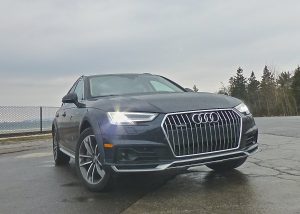
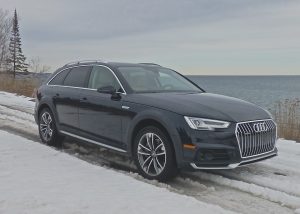
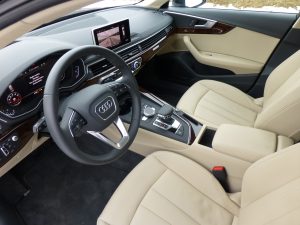
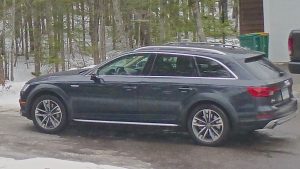
 John Gilbert is a lifetime Minnesotan and career journalist, specializing in cars and sports during and since spending 30 years at the Minneapolis Tribune, now the Star Tribune. More recently, he has continued translating the high-tech world of autos and sharing his passionate insights as a freelance writer/photographer/broadcaster. A member of the prestigious North American Car and Truck of the Year jury since 1993. John can be heard Monday-Friday from 9-11am on 610 KDAL(www.kdal610.com) on the "John Gilbert Show," and writes a column in the Duluth Reader.
John Gilbert is a lifetime Minnesotan and career journalist, specializing in cars and sports during and since spending 30 years at the Minneapolis Tribune, now the Star Tribune. More recently, he has continued translating the high-tech world of autos and sharing his passionate insights as a freelance writer/photographer/broadcaster. A member of the prestigious North American Car and Truck of the Year jury since 1993. John can be heard Monday-Friday from 9-11am on 610 KDAL(www.kdal610.com) on the "John Gilbert Show," and writes a column in the Duluth Reader.